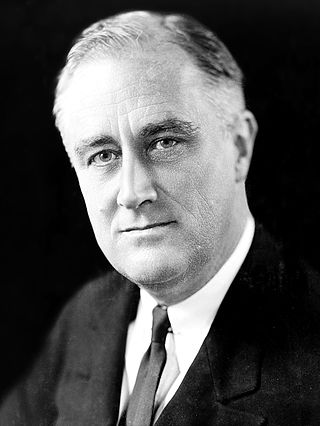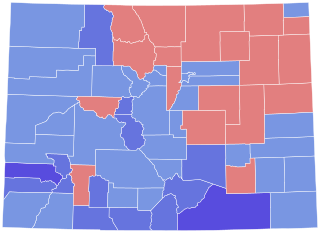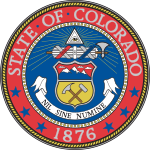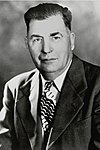
The 1924 United States presidential election was the 35th quadrennial presidential election, held on Tuesday, November 4, 1924. In a three-way contest, incumbent Republican President Calvin Coolidge won election to a full term. Coolidge was the second vice president to ascend to the presidency and then win a full term.

The 1932 United States presidential election was the 37th quadrennial presidential election, held on Tuesday, November 8, 1932. The election took place against the backdrop of the Great Depression. The incumbent Republican President Herbert Hoover was defeated in a landslide by Democrat Franklin D. Roosevelt, the governor of New York and the vice presidential nominee of the 1920 presidential election. Roosevelt was the first Democrat in 80 years to simultaneously win an outright majority of the electoral college and popular vote, a feat last accomplished by Franklin Pierce in 1852, as well as the first Democrat in 56 years to win a majority of the popular vote, which was last done by Samuel J. Tilden in 1876. Roosevelt was the last sitting governor to be elected president until Bill Clinton in 1992. Hoover was the last incumbent to lose an election to another term until Gerald Ford lost 44 years later. The election marked the effective end of the Fourth Party System, which had been dominated by Republicans. It was the first time since 1916 that a Democrat was elected president.
Southern Democrats are affiliates of the U.S. Democratic Party who reside in the Southern United States. Most of them voted against the Civil Rights Act of 1964 by holding the longest filibuster in American Senate history while Democrats in non-Southern states supported the Civil Rights Act of 1964. After 1994 the Republicans typically won most elections in the South.

In the United States Electoral College, a faithless elector is an elector who does not vote for the candidates for U.S. President and U.S. Vice President for whom the elector had pledged to vote, and instead votes for another person for one or both offices or abstains from voting. As part of United States presidential elections, each state selects the method by which its electors are to be selected, which in modern times has been based on a popular vote in most states, and generally requires its electors to have pledged to vote for the candidates of their party if appointed. A pledged elector is only considered a faithless elector by breaking their pledge; unpledged electors have no pledge to break. The consequences of an elector voting in a way inconsistent with their pledge vary from state to state.

The 1936 United States Senate election in Colorado took place on November 3, 1936. Incumbent Democratic Senator Edward P. Costigan did not seek a second term in office. Democratic Governor Ed Johnson won the open race to succeed him over Raymond L. Sauter.

The 1912 United States presidential election in Wisconsin was held on November 5, 1912 as part of the 1912 United States presidential election. State voters chose 13 electors to the Electoral College, who voted for president and vice president.

The 1920 United States Senate election in Colorado took place on November 2, 1920. Incumbent Democratic Senator Charles S. Thomas initially declined to run for re-election, and State Supreme Court Justice Tully Scott won the Democratic nomination to succeed him, facing off against former Leadville Mayor Samuel D. Nicholson, the Republican nominee. However, in October 1920, Thomas announced that he would run for re-election as the nominee of the National Party. However, Thomas's decision did not ultimately affect the outcome of the election. Aided by Republican presidential nominee Warren G. Harding's strong performance in the state, as well as Republican Governor Oliver Henry Shoup's landslide re-election, Nicholson defeated Tully and Thomas in a landslide. Out of four candidates, Thomas placed fourth, winning just 3% of the vote and finishing behind Farmer–Labor nominee G. F. Stevens.

The 1926 United States Senate election in Colorado took place on November 2, 1924. Incumbent Republican Senator Rice W. Means ran for re-election, but he was defeated in the Republican primary by Charles W. Waterman, a prominent attorney and party leader. In the general election, Waterman faced former Governor William Ellery Sweet, the Democratic nominee. Despite the nationwide Democratic trend, as well as the landslide victory for Democrats in the gubernatorial election, Waterman ended up defeating Sweet by a thin margin. Waterman would not end up serving a full term in the Senate, and died in office on August 27, 1932.

The 1930 United States Senate election in Colorado took place on November 4, 1930. Republican Senator Lawrence C. Phipps declined to run for re-election, resulting in an open race to replace him. Edward P. Costigan, one of the founding members of the Progressive Party in Colorado and a former member of the United States Tariff Commission, won the Democratic nomination and faced attorney George H. Shaw, the Republican nominee, in the general election. Aided by the nationwide Democratic landslide, Costigan handily defeated Shaw, becoming the first Democrat elected to the Senate from Colorado since 1914.

The 1912 United States presidential election in Maine took place on November 5, 1912, as part of the 1912 United States presidential election which was held throughout all contemporary 48 states. Voters chose six representatives, or electors to the Electoral College, who voted for president and vice president. Maine was won by the Democratic nominees, New Jersey Governor Woodrow Wilson and Indiana Governor Thomas R. Marshall. Wilson and Marshall defeated incumbent President William Howard Taft, and his running mate Vice President James S. Sherman and Progressive Party candidates, former President Theodore Roosevelt and his running mate California Governor Hiram Johnson.

The 1954 Colorado gubernatorial election was held on November 2, 1954. Democratic nominee Edwin C. Johnson defeated Republican nominee Donald G. Brotzman with 53.56% of the vote.

The 1934 Colorado gubernatorial election was held on November 6, 1934. Incumbent Democrat Edwin C. Johnson defeated Republican nominee Nathan C. Warren with 58.11% of the vote.

The 1926 Colorado gubernatorial election was held on November 2, 1926. Democratic nominee Billy Adams defeated Republican nominee Oliver Henry Shoup with 59.84% of the vote.

The 1932 North Dakota gubernatorial election was held on November 8, 1932. Republican nominee William Langer defeated Democratic nominee Herbert C. DePuy with 54.75% of the vote.

The 1920 Colorado gubernatorial election was held on November 2, 1920. Incumbent Republican Oliver Henry Shoup defeated Democratic nominee James M. Collins with 59.55% of the vote.

Elections were held in Illinois on Tuesday, November 3, 1936.

The 1932 Wisconsin gubernatorial election was held on November 8, 1932. Incumbent Republican Governor Philip La Follette was defeated in the Republican primary, and in the midst of the Great Depression and nationwide voter dissatisfaction with the Republican Party, Democratic nominee Albert G. Schmedeman defeated Republican nominee Walter J. Kohler Sr. and Socialist nominee Frank Metcalfe with 52.48% of the vote. Schmedeman became the first Democrat to win a gubernatorial election in Wisconsin since George Wilbur Peck in 1892. 2 years later, in 1934, La Follette would run for governor again and defeated Schmedeman, this time running with the Progressive Party.

A general election was held in the U.S. state of Wyoming on Tuesday, November 7, 1922. All of the state's executive officers—the Governor, Secretary of State, Auditor, Treasurer, and Superintendent of Public Instruction—were up for election. Democrats improved considerably from their performances in 1918, with William B. Ross winning the gubernatorial election and almost all of their statewide candidates outpacing their 1918 nominees. However, Republicans held all of the other statewide offices.

The 1932 Illinois gubernatorial election was held on November 8, 1932. It saw the election of Democrat Thomas Donavan, who defeated incumbent Republican liuetenant governor Fred E. Sterling.

The 1932 United States Senate elections in Colorado took place on November 8, 1932. Incumbent Republican Senator Charles W. Waterman announced that he would not seek re-election to a second term. Attorney Karl C. Schuyler won the Republican nomination to succeed Waterman and faced former Senator Alva B. Adams, the Democratic nominee, in the general election.



















